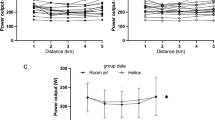Abstract
Competitive breath-hold divers (BHD) employ glossopharyngeal insufflation (GI) to increase intrapulmonary oxygen stores and prevent the lungs from dangerous compressions at great depths. Glossopharyngeal insufflation is associated with inflation of the lungs beyond total lung capacity (TLC). It is currently unknown whether GI transiently over-distends the lungs or adversely affects lung elastic properties in the long-term. Resting lung function, ventilatory drive, muscle strength, and lung compliance were measured in eight BHD who performed GI since 5.5 (range 2–6) years on average, eight scuba divers, and eight control subjects. In five BHD subsequent measures of static lung compliance (Cstat) were obtained after 1 and 3 min following GI. Breath-hold divers had higher than predicted ventilatory flows and volumes and did not differ from control groups with regard to gas transfer, inspiratory muscle strength, and lung compliance. A blunted response to CO2 was obtained in BHD as compared to control groups. Upon GI there was an increase in mean vital capacity (VCGI) by 1.75 ± 0.85 (SD) L compared to baseline (p < 0.001). In five BHD Cstat raised from 3.7 (range 2.9–6.8) L/kPa at baseline to 8.1 (range 3.4–21.2) L/kPa after maximal GI and thereafter gradually decreased to 5.6 (range 3.3–8.1) L/kPa after 1 min and 4.2 (range 2.7–6.6) L/kPa after 3 min (p < 0.01). We conclude that in experienced BHD there is a transient alteration in lung elastic recoil. Resting lung function did not reveal a pattern indicative of altered lung ventilatory or muscle function.

Similar content being viewed by others
References
ATS/ERS (2002) ATS/ERS Statement on respiratory muscle testing. Am J Respir Crit Care Med 166:518–624
Colebatch HJH, Ng CKY (1991) Decreased pulmonary distensibility and pulmonary barotrauma in divers. Respir Physiol 86:293–303
Crosbie WA, Reed JW, Clarke MC (1979) Functional characteristics of the large lungs found in divers. J Appl Physiol 46:639–645
D’Angelo E, Prandi E, Milic-Emili J (1993) Dependence of maximal flow-volume curves on time course of preceding inspiration. J Appl Physiol 75:1155–1159
Grassi B, Ferretti G, Costa M, Ferrigno M, Panzacchi A, Lundgren CE, Marconi C, Ceretelli P (1994) Ventilatory responses to hypercapnia and hypoxia in elite breath-hold divers. Respir Physiol 97:323–332
Jacobsen FL, Loring SH, Ferrigno M (2006) Pneumomediastinum after lung packing. Undersea Hyperb Med 33:313–316
Lindholm P, Nyrén S (2005) Studies on inspiratory and expiratory glossopharyngeal breathing in breath-hold divers employing magnetic resonance imaging and spirometry. Eur J Appl Physiol 94:646–651
Loring SH, O’Donnell CR, Butler JP, Lindholm P, Jacobson F, Ferrigno M (2007) Transpulmobnary pressures and lung mechanics with glossopharyngeal insufflation and exsufflation beyond normal lung volumes in competitive breath-hold divers. J Appl Physiol 102:841–846
MacIntyre N, Crapo R, Viegi G, Johnson DC, van der Grinten CPM, Brusasco V, Burgos F, Casaburi R, Coates A, Enright P, Gustafsson P, Hankinson J, Jensen R, McKay R, Miller MR, Navajas D, Pedersen OF, Pellegrino R, Wanger J (2005) Standardization of the single-breath determination of carbon monoxide uptake in the lung. Eur Respir J 26:720–735
Mador MJ, Khan S, Kufel TJ (2002) Bilateral anterolateral magnetic stimulation of the phrenic nerves can detect diaphragmatic fatigue. Chest 121:452–458
Miller MR, Hankinson J, Brusasco V, Burgos F, Casaburi R, Coates A, Crapo R, Enright P, van der Grinten CPM, Gustafsson P, Jensen R, Johnson DC, MacIntyre N, McKay R, Navajas D, Pedersen OF, Pellegrino R, Viegi G, Wanger J (2005) Standardisation of spirometry. Eur Respir J 26:319–338
Muth CM, Ehrmann U, Radermacher P (2005) Physiological and clinical aspects of apnea diving. Clin Chest Med 26:381–394
Overgaard K, Friis S, Pederson RB, Lykkeboe G (2006) Influence of lung volume, glossopharyngeal inhalation and PETO2 and PETCO2 on apnea performance in trained breath-hold divers. Eur J Appl Physiol 97:158–164
Parkes MJ (2006) Breath-holding and its breakpoint. Exp Physiol 91:1–15
Rodarte JR, Noredin G, Miller C, Brusasco V, Pellegrino R (1999) Lung elastic recoil during breathing at in creased lung volume. J Appl Physiol 87:1491–1495
Seccombe LM, Rogers PG, Mai N, Wong CK, Kritharides L, Jenkins CR (2006) Features of glossopharyngeal breathing in breath-hold divers. J Appl Physiol 101:799–801
Simpson G, Ferns J, Murat S (2003) Pulmonary effects of ‘lung packing’ by buccal pumping in an elite breath-hold diver. SPUMS J 33:122–126
Song SH, Kang DH, Kang BS, Hong SK (1963) Lung volumes and ventilatory response to high CO2 and low O2 in the ama. J Appl Physiol 18:466–470
Wanger J, Clausen JL, Coates A, Pedersen OF, Brusasco V, Burgos F, Casaburi R, Crapo R, Enright P, van der Grinten CPM, Gustafsson P, Hankinson J, Jensen R, Johnson DC, MacIntyre N, McKay R, Miller MR, Navajas D, Pellegrino R, Viegi G (2005) Standardization of the measurement of lung volumes. Eur Respir J 26:511–522
Windisch W, Hennings E, Sorichter S, Hamm P, Criee CP (2004) Peak or plateau maximal inspiratory mouth pressure: which is best? Eur Respir J 23:708–713
Windisch W, Kabitz HJ, Sorichter S (2005) Influence of different trigger techniques on twitch mouth pressure during bilateral anterior magnetic phrenic nerve stimulation. Chest 128:190–195
Author information
Authors and Affiliations
Corresponding author
Rights and permissions
About this article
Cite this article
Tetzlaff, K., Scholz, T., Walterspacher, S. et al. Characteristics of the respiratory mechanical and muscle function of competitive breath-hold divers. Eur J Appl Physiol 103, 469–475 (2008). https://doi.org/10.1007/s00421-008-0731-9
Accepted:
Published:
Issue Date:
DOI: https://doi.org/10.1007/s00421-008-0731-9




